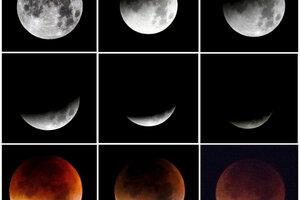Miss Sunday's supermoon eclipse? Don't wait 18 years, see photos now!
The next simultaneous occurrence of a lunar eclipse during a supermoon won't happen again until 2033. We've rounded up views of Sunday night's spectacle from around the world.

The Moon, appearing next to a statue on the Alexander III bridge, in a dim red colour, is covered by the Earth's shadow during a total lunar eclipse over Paris, France on Monday.
Philippe Wojazer/Reuters
Last night’s lunar eclipse combined with a so-called supermoon came and went in just over an hour. It was a rare astronomical treat for millions of stargazers across the world.
Those who missed the celestial phenomenon will have to wait another 18 years for their next chance to see it. But there is no shortage of photographs of the event to help them bide their time until 2033. (Click through the above photo reel for a sampling of spectacular shots from around the world.)
"You always want to see the eclipse because they're always very different," astronomer Edwin Krupp, the director of Griffith Observatory in Los Angeles, told the Associated Press.
Dr. Krupp said the earth's atmosphere adds "all kinds of twists and turns to the experience,” changing how dark and how red the moon appears. “It's always interesting to see," he added.
A large crowd filled the lawn of Griffith Observatory to watch the event while listening to Beethoven's "Moonlight Sonata.” In Boston, people climbed onto roofs in search of the best view.
It was the first time both a supermoon and lunar eclipse have overlapped since 1982. The coupling was visible in the United States, Europe, Africa, and western Asia on Sunday night and early Monday.
Robert Roy Britt of LiveScience explains how it worked:
To start with, there will be a full moon, which occurs every 29.5 days when the sun, Earth and moon are pretty well lined up, with Earth in the middle. [On Sunday], the moon is in just the right spot on its orbit — which takes it above and below the plane of Earth's orbit around the sun — so the alignment will be perfect, and Earth will cast its shadow across the face of the moon. In fact, full moons are never totally full, because when they would be, the moon is in total eclipse.
As a bonus, the moon is at its closest point to Earth right now, so it will appear slightly larger than most full moons.
The event surely didn’t disappoint for those who saw it. At the height of the eclipse, the moon turned a dark red. It was in effect watching all the world's sunrises and sunsets casting their glow on it.
This report includes material from the Associated Press.


